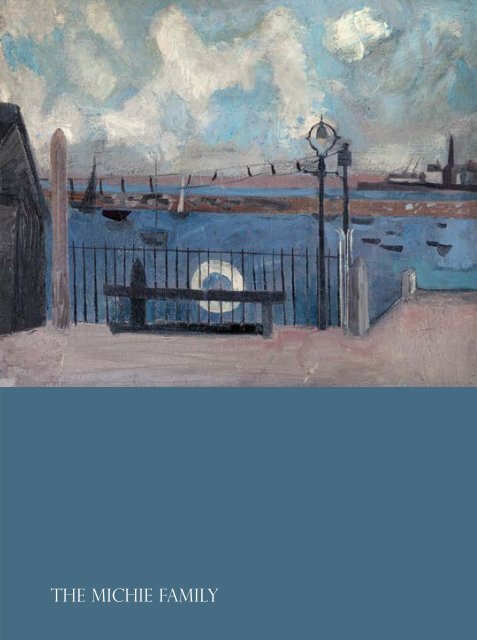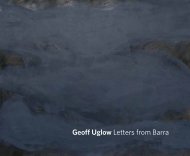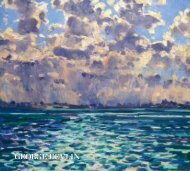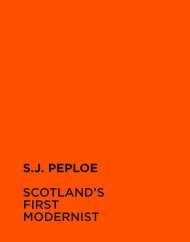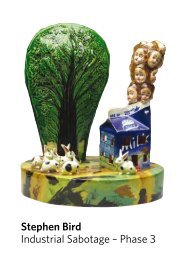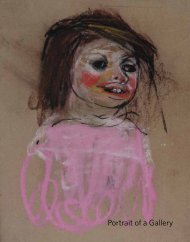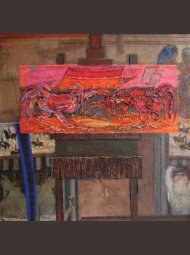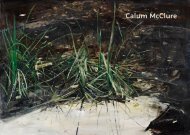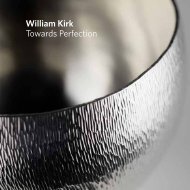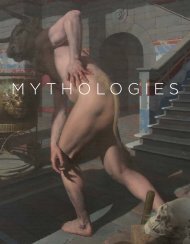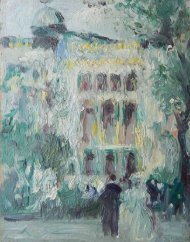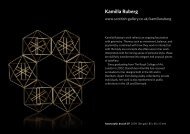Download a PDF of the exhibition catalogue - The Scottish Gallery
Download a PDF of the exhibition catalogue - The Scottish Gallery
Download a PDF of the exhibition catalogue - The Scottish Gallery
You also want an ePaper? Increase the reach of your titles
YUMPU automatically turns print PDFs into web optimized ePapers that Google loves.
THE MICHIE FAMILY
THE MICHIE FAMILY<br />
4 – 30 JUNE 2012<br />
16 Dundas Street, Edinburgh EH3 6HZ<br />
Tel 0131 558 1200 Email mail@scottish-gallery.co.uk<br />
Web www.scottish-gallery.co.uk<br />
Front cover: David Michie, At <strong>the</strong> Harbour, Granton, 1953, oil on canvas, 56 x 69 cms<br />
Inside covers: James Michie, Bristol Construction Site, 1955, pencil, 66 x 85 cms
foreword<br />
It is not uncommon for some artistic talent to pass onto <strong>the</strong> next generation and for a number <strong>of</strong> siblings and children<br />
to pursue a similar creative pathway. Anne Redpath is recognized as one <strong>of</strong> <strong>the</strong> greatest painters <strong>of</strong> her generation; her<br />
reputation grew beyond <strong>the</strong> confines <strong>of</strong> Scotland in her lifetime and continues to grow. Two <strong>of</strong> her sons, David and Alastair<br />
have pursued careers in painting, although quite separately. <strong>The</strong>y both used <strong>the</strong>ir own family name, Michie, that came<br />
from <strong>the</strong>ir fa<strong>the</strong>r James and for many it will be his group <strong>of</strong> paintings which provides <strong>the</strong> surprise in this family <strong>exhibition</strong>.<br />
He was an architect/peintre who perhaps suffered as a painter because <strong>of</strong> his chosen pr<strong>of</strong>ession as an architect. Architecture<br />
has long been accepted as a pillar equal to painting in <strong>the</strong> academies <strong>of</strong> <strong>the</strong> arts but pr<strong>of</strong>essional duties and affiliations put a<br />
restraint on <strong>the</strong> architect’s ability to be accepted as a painter beyond <strong>the</strong> expectation <strong>of</strong> competence. For James Michie <strong>the</strong><br />
burgeoning talent <strong>of</strong> his wife may have put a fur<strong>the</strong>r barrier in <strong>the</strong> way <strong>of</strong> a full flowering <strong>of</strong> his own ability. Diffidence, a lack<br />
<strong>of</strong> hard work, jealousies and an absence <strong>of</strong> self-belief have undermined many potentially successful careers and sometimes<br />
<strong>the</strong> furnace <strong>of</strong> one man’s genius can consume <strong>the</strong> lesser abilities <strong>of</strong> his immediate family. For <strong>the</strong> Michie boys painting was<br />
not a family business (in <strong>the</strong> sense <strong>of</strong> <strong>the</strong> Renaissance family atelier) but two individuals combining natural talents with<br />
a steely determination to pursue <strong>the</strong>ir own star. For Lindsay, <strong>the</strong> middle son, different, practical gifts launched him on a<br />
business career with GEC which many would consider as equally ‘successful’ as <strong>the</strong> mercurial Alastair or David, prospering<br />
at Edinburgh College <strong>of</strong> Art. Some will look at this <strong>exhibition</strong> and see family likenesses in approach to painting. All will have<br />
a glimpse <strong>of</strong> family life, with <strong>the</strong> inclusion <strong>of</strong> one piece <strong>of</strong> Redpath-adorned furniture, and truly <strong>the</strong>ir mo<strong>the</strong>r’s personality<br />
expressed large in her work and her home must have been somehow formative on <strong>the</strong> children.<br />
Guy Peploe<br />
Lindsay, David and Alastair at Eyemouth c.1940; Michie boys and<br />
friends at Chateau Gloria c.1932; Anne in St Omer 1921; Alastair;<br />
James in Uniform c.1914; David; Anne at Edinburgh College <strong>of</strong><br />
Art c.1915; Anne Redpath<br />
2
James Beattie Michie<br />
(1891–1960)<br />
Though born in Inverness, James Michie was from a family firmly based in Hawick. He attended school <strong>the</strong>re, and <strong>the</strong>reafter<br />
was apprenticed to an architectural practice, Alan Hopkirk, in that town. My fa<strong>the</strong>r joined <strong>the</strong> army in 1914 when war broke<br />
out and served in <strong>the</strong> Royal Scots Regiment. Several years were spent on <strong>the</strong> Western Front, and he was <strong>the</strong>n despatched to<br />
India, serving in <strong>the</strong> 54th Sikh Regiment.<br />
Married in 1920 to Anne Redpath, he was apprenticed that year to <strong>the</strong> War Graves Commission, and joined o<strong>the</strong>r,<br />
mainly young, architects under <strong>the</strong> direction <strong>of</strong> Edwin Lutyens, tasked in <strong>the</strong> design and layout <strong>of</strong> <strong>the</strong> many war cemeteries,<br />
big and small, that were spread about in <strong>the</strong> north-east corner <strong>of</strong> France. My fa<strong>the</strong>r’s interest in painting can be seen<br />
developing at that time, and <strong>the</strong> landscape, <strong>of</strong>ten featuring a windmill, became a subject <strong>of</strong> attraction. An interest in painting<br />
remained throughout his life. This was not particularly unusual for an architect. Charles Rennie Mackintosh and o<strong>the</strong>rs have<br />
shown much skill and achievement in painting.<br />
Moving to <strong>the</strong> south <strong>of</strong> France in <strong>the</strong> late 20’s, my fa<strong>the</strong>r became a private architect to a wealthy American, Charles<br />
Thompson, who had bought a large villa, he named Chateau Gloria, at St Jean on Cap Ferrat, adjacent to Villefranche.<br />
He carried out a number <strong>of</strong> projects – a loggia, a swimming pool in <strong>the</strong> large garden <strong>of</strong> <strong>the</strong> estate, and o<strong>the</strong>r projects within<br />
<strong>the</strong> chateau. In 1931 he was commissioned to paint two murals in <strong>the</strong> Chapelle St Roseline at a Carthusian Monastery,<br />
Chartreuse Notre-Dame de Montrieux, situated in wooded country about 30 kilometres north <strong>of</strong> Toulon.<br />
Thompson lost much <strong>of</strong> his wealth during <strong>the</strong> years following <strong>the</strong> 1929 crash and in 1934 he sold <strong>the</strong> chateau,<br />
returning to America, and <strong>the</strong> Michie family moved back to Hawick. Employment prospects at this time were bleak, but<br />
my fa<strong>the</strong>r was fortunate to be appointed to a prominent architecture practice, Charles Holden and Partners, in London.<br />
When war broke out in 1939, he volunteered to join <strong>the</strong> army and was placed in <strong>the</strong> Gloucestershire Regiment and, no doubt<br />
because <strong>of</strong> his <strong>Scottish</strong> background, was appointed as requisitioning <strong>of</strong>ficer for <strong>the</strong> Borders. He spent <strong>the</strong> war years based<br />
in Galashiels, attending to <strong>the</strong> needs <strong>of</strong> <strong>the</strong> thousands <strong>of</strong> soldiers who required billeting in <strong>the</strong> Borders region. He had time<br />
to make paintings, surprisingly. After <strong>the</strong> war he was appointed as a lecturer at <strong>the</strong> West <strong>of</strong> England School <strong>of</strong> Architecture<br />
in Bristol. He balanced his time teaching architecture to his students and making paintings, and held <strong>exhibition</strong>s <strong>the</strong>re.<br />
It was a varied life with different experiences. Making paintings was a constant thread.<br />
David Michie<br />
April 2012<br />
4
Borders Landscape, c.1944<br />
watercolour on paper laid on board, 44 x 53 cms<br />
5
Landscape, Nor<strong>the</strong>rn France<br />
oil on canvas, 43 x 58 cms<br />
6
Bristol Construction Site, 1955<br />
pencil, 66 x 85 cms<br />
7
Two Figures<br />
oil on canvas, 61 x 61 cms<br />
8
Still Life with Chinese Figures<br />
oil on canvas, 64 x 73 cms<br />
9
anne redpath<br />
(1895–1965) OBE, RSA, ARA, RWA<br />
Anne Redpath was born on <strong>the</strong> 29th <strong>of</strong> March, 1895 in Galashiels in <strong>the</strong> heart <strong>of</strong> <strong>the</strong> <strong>Scottish</strong> Borders. Her fa<strong>the</strong>r Thomas<br />
Redpath was a celebrated tweed designer who was recognised both as an innovator and exceptional colourist. It was not just<br />
an eye for colour that Anne inherited from her fa<strong>the</strong>r, but a focus and pr<strong>of</strong>essionalism to her craft which was to drive her<br />
throughout her life. One <strong>of</strong> four children, Anne attended Hawick High School where her artistic talent was spotted by <strong>the</strong><br />
art teacher John Gray (later to be president <strong>of</strong> <strong>the</strong> Royal Society for Painters in Watercolour).<br />
Anne arrived at Edinburgh College <strong>of</strong> Art in 1913, although she had to simultaneously attend a teacher training<br />
course at Moray House to keep her fa<strong>the</strong>r happy. Graduating with a diploma in 1918, she was also awarded a year’s postgraduate<br />
study followed by a travelling scholarship <strong>the</strong> following year. She visited Brussels, Bruges, Paris, Florence and most<br />
importantly, Sienna. Her encounter with <strong>the</strong> Siennese Primitives was to impress her greatly. It was <strong>the</strong>ir simplification <strong>of</strong><br />
form partnered with a powerful vision that had most resonance with her, and <strong>the</strong>ir influence is seen in her landscapes <strong>of</strong> <strong>the</strong><br />
1920s and 30s as well as work from <strong>the</strong> end <strong>of</strong> her life. On her return from her travels Anne was engaged to James Michie,<br />
a young architect also from <strong>the</strong> Borders. <strong>The</strong>y married in 1920 and almost immediately moved to St Omer in Nor<strong>the</strong>rn<br />
France, where James was working for <strong>the</strong> War Graves Commission. It was in St Omer where <strong>the</strong> first two Michie sons were<br />
born. She did have a small <strong>exhibition</strong> in St Omer in 1921 (and again in St. Raphael in 1928) but at this stage Anne’s painting<br />
took a back seat, her priorities were with her young family. <strong>The</strong>y had moved again at this point to St. Jean, Cap Ferrat near<br />
Nice. Although painting was not her first priority at this time, her drive as an artist was by no means diminished. In her own<br />
words:<br />
‘Young women <strong>of</strong>ten come up to me and say: “I am going to be like you and give up everything for painting”, but<br />
that’s not how I see it at all. I could never have sacrificed my family to painting, and I don’t think anyone else should ei<strong>the</strong>r…<br />
I put everything I had into house and furniture and dresses and good food and people. All that’s <strong>the</strong> same sort <strong>of</strong> thing as<br />
painting really, and <strong>the</strong> experience went back into art when I began painting again.’<br />
When she returned to Hawick in 1934 <strong>the</strong> landscape <strong>of</strong> her childhood <strong>of</strong>fered much inspiration; winter light,<br />
bare trees and swollen rivers <strong>of</strong> <strong>The</strong> Borders. In her studio she painted a few memorable figure compositions including<br />
touching family portraits, three <strong>of</strong> which feature in this <strong>exhibition</strong>. Increasingly, tabletop still lifes became a favourite subject<br />
and were to make her reputation, (and as James had moved to London in search <strong>of</strong> work) her livelihood. Her palette during<br />
<strong>the</strong> 1930s was at first muted and <strong>the</strong>re is both a delicacy in application and mastery <strong>of</strong> pale tones and areas <strong>of</strong> jewel-like<br />
colour. Her landscapes, painted in <strong>the</strong> studio are a distillation <strong>of</strong> experience; her choice <strong>of</strong> what to include and exclude in<br />
her design part <strong>of</strong> her character as a picture maker.<br />
In <strong>the</strong> 1950s and until her death in 1965 she travelled extensively (<strong>of</strong>ten with her sons in tow!), which hugely<br />
enriched <strong>the</strong> scope <strong>of</strong> her subject matter. She always brought back exotic objects for <strong>the</strong> studio and sketchbooks full <strong>of</strong><br />
material for her oils. Her first trip back to <strong>the</strong> continent was in 1949, and again in 1950. She travelled to Spain in <strong>the</strong> spring<br />
<strong>of</strong> 1951 with her friend Bill Garrad. <strong>The</strong> harsh landscape and stark light <strong>of</strong> <strong>the</strong> Spanish countryside astounded her, and was<br />
very different from <strong>the</strong> warm, gentleness <strong>of</strong> <strong>the</strong> South <strong>of</strong> France. It engendered a change which was to affect her practice<br />
for <strong>the</strong> last years <strong>of</strong> her life;<br />
‘If one painted nothing but still-life one would fall into <strong>the</strong> narrow range <strong>of</strong> one’s own natural selection. To go to<br />
Spain and find dark grey skies and white villages; to Italy and find that <strong>the</strong> sky is more violet than blue; to Corsica and find<br />
violets and scarlets on <strong>the</strong> hillsides; all this enlarges one’s range <strong>of</strong> colour and responsiveness.’<br />
10
Like most <strong>of</strong> <strong>the</strong> edinburgh School painters she divided her output between oil and working on paper, valuing each<br />
<strong>the</strong> same. Latterly in her flowers, townscapes and church interiors her treatment <strong>of</strong> <strong>the</strong> canvas became more abstract as she<br />
abandoned traditional spatial composition. Her technique developed also, employing <strong>the</strong> palette knife as much as <strong>the</strong> brush<br />
and using rich and brilliant colour.<br />
redpath was an inspirational person and formed many enduring friendships. Her flat in London Street became an<br />
artistic salon, immortalised by robin Philipson’s affectionate group portrait now in <strong>The</strong> <strong>Scottish</strong> National Portrait <strong>Gallery</strong>.<br />
Since her death her reputation has been fur<strong>the</strong>r enhanced with retrospectives including an <strong>exhibition</strong> at <strong>The</strong> <strong>Scottish</strong><br />
National <strong>Gallery</strong> <strong>of</strong> Modern Art in 1996. She was a woman devoted to her family as well as her art. This <strong>exhibition</strong> features<br />
early Borders landscapes, sparse and immediate, as well as later works: still lifes rich in colour and texture reminding us <strong>of</strong><br />
<strong>the</strong> breadth <strong>of</strong> her artistic ability. <strong>The</strong>re is youthful sense <strong>of</strong> enquiry throughout her work and a delight in her subject matter<br />
which is individual and always vivacious.<br />
Portrait <strong>of</strong> David as a baby<br />
pastel on paper, 29 cms diameter<br />
11
<strong>The</strong> White Azalea<br />
oil on canvas, 51 x 76 cms<br />
12
Menton<br />
gouache, 53 x 38 cms<br />
13
Spring Trees<br />
gouache, 35 x 48 cms<br />
14
Borders River<br />
gouache, 35.5 x 50.5 cms<br />
15
Corsican Village<br />
lithograph, 22 x 30 cms<br />
16
Church from <strong>the</strong> Window<br />
pen & watercolour, 50 x 40 cms<br />
17
Jug with Fruit (blue & red)<br />
lithograph, 28 x 45 cms<br />
18
Flowers in a Teapot<br />
ink & watercolour, 24.5 x 32.5 cms<br />
19
Summer Flowers in a Green Vase<br />
oil, 46 x 35.5 cms<br />
20
White Geraniums, 1962<br />
oil on board, 51 x 61 cms<br />
21
Street in Menton – A Spanish Street<br />
gouache, 37 x 45.5 cms<br />
22
<strong>The</strong> Angel Gabriel from <strong>the</strong> Chapel <strong>of</strong> St Jean, Treboul<br />
gouache, 36 x 27.5 cms<br />
23
Alastair Michie<br />
(1921–2008) RWA, FRBS<br />
<strong>The</strong> oldest <strong>of</strong> <strong>the</strong> Michie boys Alastair was born in St. Omer, France in 1921 attending French schools until <strong>the</strong> age <strong>of</strong> 12.<br />
When <strong>the</strong> family moved back to <strong>the</strong> Borders he continued his schooling in Hawick. After gaining a scholarship to Edinburgh<br />
College <strong>of</strong> Art he followed in his fa<strong>the</strong>r’s footsteps and studied architecture. While at university he enlisted in <strong>the</strong> University<br />
Air Squadron and at <strong>the</strong> outbreak <strong>of</strong> War he travelled to Florida to begin his training. Miraculously Alastair survived <strong>the</strong><br />
War having served with distinction as a night fighter pilot over German lines. When <strong>the</strong> War ended he was reluctant to<br />
return to ano<strong>the</strong>r three years <strong>of</strong> study and decided to apply his talent as a draughtsman to <strong>the</strong> art <strong>of</strong> illustration. He became<br />
an extremely successful fashion illustrator and designer, eventually gaining international recognition. It was at this stage that<br />
Alastair moved from London to Wareham in Dorset, where he would remain for <strong>the</strong> rest <strong>of</strong> his life.<br />
In 1963 Alastair and his mo<strong>the</strong>r made a trip to Venice which was to dramatically change his direction as an artist.<br />
At <strong>the</strong> Biennale he saw firsthand <strong>the</strong> abstract expressionist works brought over from New York. <strong>The</strong> sheer scale and energy <strong>of</strong><br />
Mark Rothko, Franz Kline and Robert Mo<strong>the</strong>rwell were critical in his decision to become a painter and elicited a desire to<br />
paint in a way that <strong>the</strong> example set by his mo<strong>the</strong>r had not. Alastair met Mark Rothko after his friend John Plumb’s <strong>exhibition</strong><br />
opening at <strong>the</strong> Axiom <strong>Gallery</strong> in London a few years later. It was an encounter that confirmed his belief that abstraction was<br />
a vehicle for universal human emotion. Although now into his 40s this experience engendered a drastic change in his artistic<br />
direction and triggered a desire to become a painter full time (much to <strong>the</strong> surprise <strong>of</strong> his family!). Alastair always distanced<br />
himself from his mo<strong>the</strong>r’s influence, proclaiming: “my mo<strong>the</strong>r’s work did not influence me”. However it is not farfetched to<br />
see, Anne Redpath’s feeling for colour and texture is evident in her son’s mature work.<br />
Alastair’s work whe<strong>the</strong>r painting or sculpture was always influenced by his own experience and environment.<br />
His work in both disciplines was always closely linked to <strong>the</strong> landscape and Jurassic coastline <strong>of</strong> his beloved Dorset. Images<br />
<strong>of</strong> land and sea viewed from above inspired him and his work Target from 2004, shows clearly <strong>the</strong> influence <strong>of</strong> his wartime<br />
experiences. Local beaches also proved to be a rich source <strong>of</strong> inspiration. On a first trip to Studland beach he discovered<br />
jagged pieces <strong>of</strong> metal, shrapnel and unexploded shells which were to inspire his striking series <strong>of</strong> sculptures he called<br />
Shrapnel. Endeavour, a 15 foot bronze commissioned by British Aerospace in Bristol is a mixture <strong>of</strong> organic and mechanic<br />
form: its dynamic shape evokes <strong>the</strong> striking silhouette <strong>of</strong> a fighter’s tailplane. A smaller version is available in this <strong>exhibition</strong>.<br />
Since ideas <strong>of</strong> structure and design ran parallel with more evocative and poetic ideas in his work, Alastair’s decision<br />
to sculpt seemed a natural progression. However it is for painting that Alastair is better known. His first <strong>exhibition</strong> was<br />
put on in Edinburgh’s Traverse <strong>The</strong>atre in 1964 and featured richly coloured and textured acrylics (see Ammonite opposite)<br />
related to <strong>the</strong> American painters he admired. He enjoyed a major solo <strong>exhibition</strong> in Sao Paulo, Brazil in 1972 and <strong>the</strong> art<br />
museums both in Sao Paulo and Rio acquired his work for <strong>the</strong>ir permanent collections. In 1979 <strong>the</strong>re was a major <strong>exhibition</strong><br />
<strong>of</strong> his sculpture at <strong>the</strong> Alwin <strong>Gallery</strong>, London.<br />
In 1982 he became a Royal West <strong>of</strong> England Academician and a fellow <strong>of</strong> <strong>the</strong> Royal Society <strong>of</strong> British Sculptors in<br />
1994. He enjoyed a solo <strong>exhibition</strong> at <strong>the</strong> Mall <strong>Gallery</strong> in 1996 and ano<strong>the</strong>r with Archeus Fine Art in 2000. In 2007 he was<br />
awarded an honorary doctorate from Bournemouth University.<br />
24
Ammonite, c.1962<br />
mixed media on canvas, 100 x 120 cms<br />
25
Cool, c.2006<br />
mixed media on canvas, 142 x 142 cms<br />
26
Endeavour, 1989<br />
bronze, edition 4/5, 20 cms height x 17 cms width<br />
African Head <strong>of</strong> a Girl, c.1960<br />
cast aluminium, edition 2/5, 19 cms height<br />
27
Fathom, c.1992<br />
acrylic on board, 56 x 102 cms<br />
28
Solo, c.2008<br />
acrylic on board, 50 x 60 cms<br />
29
Paper Roses, c.1987<br />
acrylic on board, 57 x 71 cms<br />
30
Margins XXI, c.2002<br />
acrylic on board, 90 x 70 cms<br />
31
Fishing Boats Chioggia, c. 1967<br />
mixed media on board, 24 x 21 cms<br />
32
Fashion Drawing I<br />
pastel, 53 x 30 cms<br />
Fashion Drawing II<br />
mixed media, 53 x 40 cms<br />
33
Fashion Drawing III<br />
mixed media, 46 x 40 cms<br />
Fashion Drawing IV<br />
mixed media, 49 x 40 cms<br />
Fashion Drawing VI<br />
mixed media, 39 x 33 cms<br />
Fashion Drawing VII<br />
mixed media, 54 x 39 cms<br />
34
Fashion Drawing XIII<br />
mixed media, 66 x 44 cms<br />
35
david Michie<br />
(b.1928) OBE, RSA, FRSA<br />
<strong>The</strong> youngest <strong>of</strong> <strong>the</strong> Michie boys, David was born in St. Raphael in 1928. He studied at Edinburgh College <strong>of</strong> Art from<br />
1947–53 under <strong>the</strong> painter, William Gillies. He was awarded a travelling scholarship upon graduating and travelled to Italy<br />
in 1953 with fellow painter and friend John Houston. On returning to Edinburgh he took up a post at <strong>the</strong> College <strong>of</strong> Art,<br />
becoming Head <strong>of</strong> Drawing and Painting from 1982–90.<br />
David’s first years immersed in <strong>the</strong> light and sun soaked landscape <strong>of</strong> <strong>the</strong> South <strong>of</strong> France were to have a lasting effect<br />
on him. Not only did it give him awareness <strong>of</strong> colour, but it gave him a taste for a life outside Scotland that was to inspire a<br />
love for travel he has kept throughout his life. On returning to Hawick at <strong>the</strong> age <strong>of</strong> eight he was placed in a landscape <strong>of</strong> a<br />
different sort, but <strong>the</strong> vistas <strong>of</strong> <strong>the</strong> Lammermuirs, fields and woods around Hawick did not fascinate him in <strong>the</strong> same way<br />
<strong>the</strong>y captured his mo<strong>the</strong>r. David’s gaze was more focused, enticed by <strong>the</strong> smaller aspects <strong>of</strong> <strong>the</strong> natural world; a dragon fly<br />
skimming across a pond’s surface.<br />
David’s lack <strong>of</strong> interest in conventional landscape painting led him to create a visual language completely unique.<br />
Not constricted by academic drawing, his compositions <strong>of</strong> flora and fauna are simplified in form and <strong>of</strong>ten float in an<br />
ambiguous space <strong>of</strong> flattened colour and pattern as in Seed Pods and Cosmos. <strong>The</strong> world that <strong>the</strong> artist describes is abundant<br />
and diverse and appeals directly to our senses. His figure subjects, (images <strong>of</strong>ten inspired by foreign travel) which can feature<br />
subjects as diverse as jazz musicians, skateboarders or fisherman, are all perfect snapshots <strong>of</strong> <strong>the</strong> bizarre natural drama <strong>of</strong><br />
human experience. His most recent works focus on <strong>the</strong> <strong>the</strong>me <strong>of</strong> Midnight Tango, and are made with <strong>the</strong> same wit, strong<br />
colour and harmonious design which David Michie has become renowned for.<br />
David followed in his mo<strong>the</strong>r’s footsteps choosing to live in Edinburgh and become a prominent member <strong>of</strong> <strong>the</strong><br />
second generation <strong>of</strong> <strong>The</strong> Edinburgh School. Along with his friends and contemporaries Elizabeth Blackadder and John<br />
Houston, Michie’s contribution to <strong>Scottish</strong> painting is as an original image maker but also as a painter who believes in<br />
painting; a serious pursuit but one also which can give great pleasure.<br />
<strong>The</strong> 17 works in this <strong>exhibition</strong> <strong>of</strong>fers a modest review <strong>of</strong> David’s career and includes two early Edinburgh cityscapes;<br />
letting us wonder again at <strong>the</strong> originality <strong>of</strong> <strong>the</strong> artist and see <strong>the</strong> world though his eyes.<br />
He is an elected member <strong>of</strong> <strong>the</strong> Royal <strong>Scottish</strong> Academy, <strong>The</strong> Royal Glasgow Institute and past President <strong>of</strong> <strong>the</strong><br />
Society <strong>of</strong> <strong>Scottish</strong> Artists. He was awarded an OBE in 1997. His paintings are held in <strong>the</strong> collection <strong>of</strong> H.M. <strong>The</strong> Queen,<br />
<strong>The</strong> <strong>Scottish</strong> Arts Council, <strong>The</strong> <strong>Scottish</strong> National <strong>Gallery</strong> <strong>of</strong> Modern Art and o<strong>the</strong>r major public collections <strong>of</strong> <strong>Scottish</strong> art.<br />
36
At <strong>the</strong> Harbour, Granton, 1953<br />
oil on canvas, 56 x 69 cms<br />
37
By <strong>the</strong> Bridge, Leith, 1953<br />
oil on canvas, 69 x 56 cms<br />
38
Rosemount Building, Gardners Crescent, 1964<br />
oil on canvas, 86 x 112 cms<br />
39
Skunk Cabbage Flowers – Arduaine, 1986<br />
oil on canvas, 91.5 x 127 cms<br />
40
Convolvulus Hawkmoth at a Flower, 1995<br />
oil on canvas, 38 x 38 cms<br />
41
Seed Pods and Cosmos, 2010<br />
oil on canvas, 86 x 86 cms<br />
42
Damsel Fly on a Leaf, 1995<br />
oil on canvas, 38 x 38 cms<br />
43
Trumpet Player at Cork, 1996<br />
oil on canvas, 38 x 38 cms<br />
44
George Melly at <strong>the</strong> Festival <strong>The</strong>atre, 1998<br />
oil on canvas, 38 x 38 cms<br />
45
Bending over Backwards, 2011<br />
oil on board, 20 x 20 cms<br />
Brief Encounter, 2011<br />
oil on board, 20 x 20 cms<br />
46
Dancing in <strong>the</strong> Bar Room, 2011<br />
oil on board, 20 x 20 cms<br />
Kicking Out, 2011<br />
oil on board, 20 x 20 cms<br />
47
Published by <strong>The</strong> <strong>Scottish</strong> <strong>Gallery</strong> to coincide with <strong>the</strong> <strong>exhibition</strong><br />
<strong>the</strong> MICHIE FAMILY<br />
4 – 30 JUNE 2012<br />
Exhibition can be viewed online at www.scottish-gallery.co.uk/<strong>the</strong>michiefamily<br />
Our warm thanks to all <strong>the</strong> Michie family for making <strong>the</strong> <strong>exhibition</strong> possible.<br />
ISBN 978-1-905146-67-3<br />
Designed by www.kennethgray.co.uk<br />
Photography by William Van Esland Photography<br />
Printed by J Thomson Colour Printers<br />
All rights reserved. No part <strong>of</strong> this <strong>catalogue</strong> may be reproduced in any form by<br />
print, photocopy or by any o<strong>the</strong>r means, without <strong>the</strong> permission <strong>of</strong> <strong>the</strong> copyright<br />
holders and <strong>of</strong> <strong>the</strong> publishers.<br />
16 Dundas Street, Edinburgh EH3 6HZ<br />
Tel 0131 558 1200 Email mail@scottish-gallery.co.uk<br />
Web www.scottish-gallery.co.uk<br />
Back cover: Anne Redpath, Borders Landscape, gouache, 51 x 35.5 cms<br />
48


